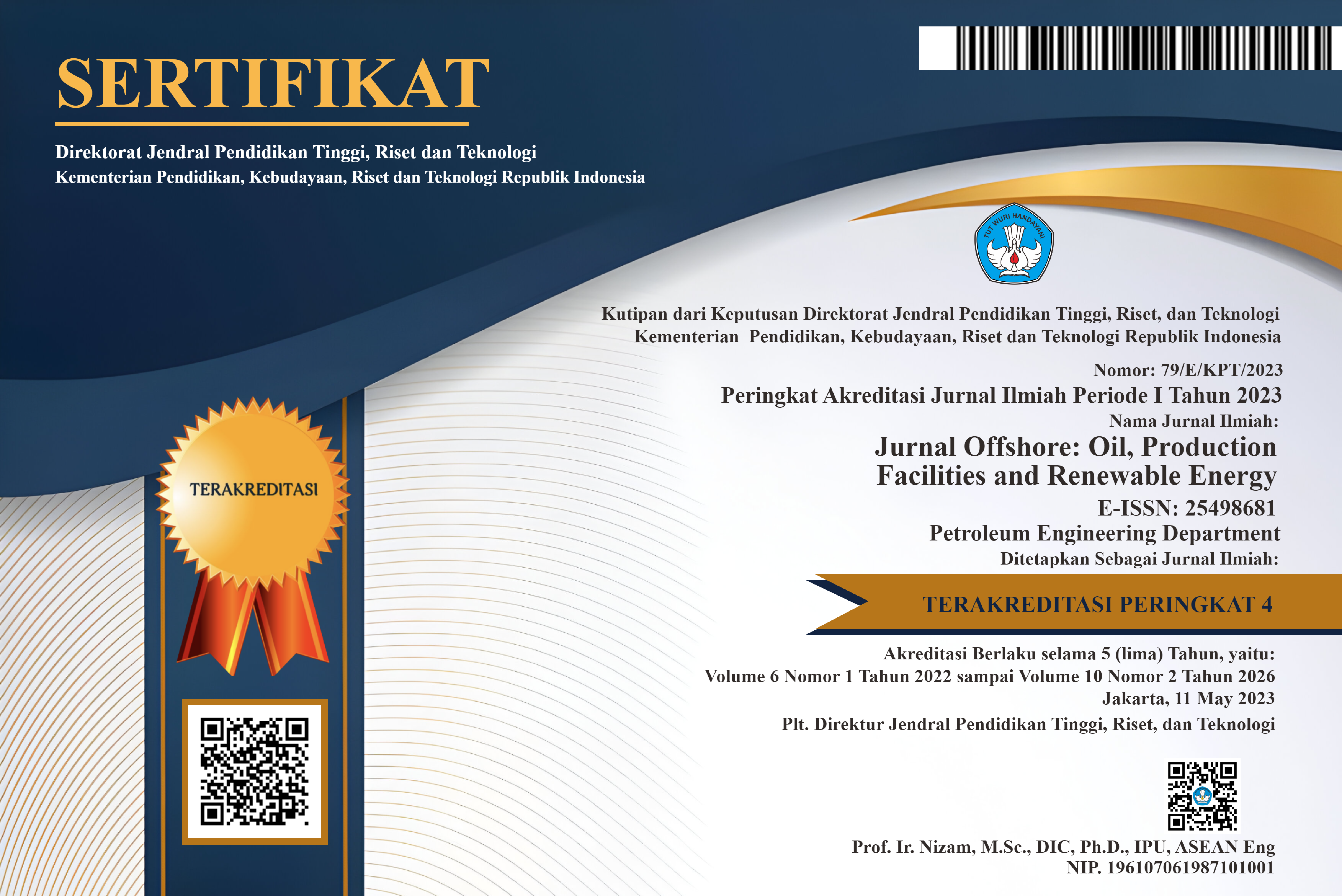Analisa Kesekatan Sesar dan Kompartemen Lapisan Berdasarkan Analisis Petrofisika dan Attribut Seismik pada Formasi Talang Akar, Sub Cekungan Jambi
DOI:
https://doi.org/10.30588/jo.v1i2.289Keywords:
shale gauge ratio, seismik attribut, porositas, saturasi, seismic attribute, porosity, saturationAbstract
Daerah penelitian terletak pada Sub Cekungan Jambi. Fokus utama dalam penelitian ini adalah melakukan pendekatan mengenai stuktur yang berkembang di daerah penelitian yang dapat bersifat sebagai tempat akumulasi atau jalur migrasi dengan menggunakan metode SGR (Shale Gauge Ratio), rekonstrusi tektonik berdasarkan data seismik diharapkan dapat menjawab kompartemenisasi lapisan reservoar pada Formasi Talang Akar dan migrasi fluida hidrokarbon pada reservoar. Berdasarkan analisis terhadap sumur Alpha-1 dan Betha-1 terdapat lapisan prospek hidrokarbon yang merupakan lapisan Formasi Talang Akar. Pada Alpha-1 zona prospek berada pada kedalaman 1436,6–1456,6 m (TVDSS) diberi nama TAF 1 memiliki porositas efektif rata-rata 0,1281; saturasi air rata-rata 0,34 dengan nilai Rt rata-rata 1794 ohm m dan Rw 0,4 ohmm. Pada sumur Betha-1 zona prospek berada pada kedalaman 1448 m – 1456,5 m (TVDSS) dengan porositas efektif rata-rata pada zona ini 0,129; saturasi air rata-rata 0,586 dengan nilai Rt rata-rata 32,2 ohm m dan nilai Rw 0,9 ohmm. Sifat kesekatan sesar pada sesar yang dianalisa adalah leak dengan ratio SGR 15 %, serta lapisan yang tersesarkan merupakan lapisan reservoar dari Formasi Talang Akar yang sama. Pergerakan fluida hidrokarbon (migrasi) terjadi secara intraformasi (terjadi pada formasi yang sama).
The research area is located in the Jambi Sub-Basin. The focus of this study was the structure in this sub basin, fault which can be a trap or migration route, which can defined using SGR (Shale Gauge Ratio) method. This study also resulted in reconstruction of the tectonics history to know the compartements between reservoir (Talang Akar Formation) and to know the migration of hydrocarbon. Based on the analysis of the well Alpha-1 and Betha-1, there is a layer of hydrocarbon prospects in Talang Akar Formation. At ALPHA 1, prospect zone at depth of 1436.6 to 1456.6 m (TVDSS) named TAF 1 has an average effective porosity 0.1281, the average water saturation of 0.34 with an average permeability in this zone is 20, Rt 62 mD with an average value of 1794 ohm m and Rw 0.4 ohmm. The Betha-1 wells prospects zone at depth of 1448–1456,5 m (TVDSS) with an average effective porosity in this zone is 0,129 average water saturation of 0,586, permeability 19,6 mD with an average value of Rt 32,2 ohm m and Rw value of 0.9 ohm m. The conclusion of fault seal in analysis that separated two layers is leaking with SGR ratio of 15%, as well as layers that faulted the reservoir layer of the same Talang Akar Formation. The movements of hydrocarbon as intraformation (in one formation migration).
References
Anonim, 1998, POD Struktur Bungin Batu dan Rengan Condong, Pertamina.
Barnes, A.E.. 1999. Seismic attributes past, present, and future: 69th Annual Internat. Mtg., Soc. Expl. Geophys., Expanded Abstracts, 892-895.
Chien, Q., dan Sidney, S., 1997, Seismic Attribute Technology for Resevoir Forecasting and Monitoring, Western Atlas International Inc., Houston, Texas.
Dee, S, 2005 :Faults Seal Analysis Training Course, Badley TrapTester Version 5.3, Jakarta.
Fisher,Q.J., Jones, G. dan Knipe,R.J. 1998. Faulting, Fault Sealing and Fluid Flow in Hydrocarbon Reservoirs. The Geological Society, London, UK.
Ginger, D. dan Fielding, K., 2005, The Petroleum System And Future Potential Of The South Sumatra Basin. Indon. Petroleum Assoc. 30 th Ann. Conv. Proc., p. 67-89.
Lindsay, N.G., Murphy, E.C., Walsh, dan J.J., Watterson, J., 1993. Outcrop studies of shale smears on fault surface. International Association of Sedimentology.
Smith, D. A., 1980, Sealing and Nonsealing Faults in Lousiana Gulf Coast Salt Basin, The American Association of Petroleum Geologist Bulletin, v. 64, p. 145-172.
Watts, N., 1987. Theoritical aspects of cap rock and faults seals for single and two- phase hydrocarbon columns. Mar. Pet. Geol.
White, R.E., 1991, Properties of instantaneous seismic attributes: The Leading Edge, 10, no. 7, 26-32.
Yielding, G., B. Freeman., dan D.T. Needham, 1997, Quantitative Fault Seal Prediction, The American Association of Petroleum Geologist Bulletin, v. 81, p. 897-917.
Yielding, G., 2002, Shale Gouge Rati-Calibration By Geohystory, NPF Special Publication 11, p. 1-15.
Yielding, G., Overland, J.A., dan Byberg, G., 1999, Characterization of Fault Zones for Reservoir Modeling : An Example from The Gullfaks Field, Northern Sea. The American Association of Petroleum Geologist Bulletin, v. 83, p. 92
Downloads
Published
How to Cite
Issue
Section
License
Authors retain copyright and grant the Jurnal Offshore right of first publication with the work simultaneously licensed under a Creative Commons Attribution 4.0 International License that allows others to share (copy and redistribute the material in any medium or format) and adapt (remix, transform, and build upon the material) the work for any purpose, even commercially with an acknowledgement of the work's authorship and initial publication in Jurnal Offshore. Authors are able to enter into separate, additional contractual arrangements for the non-exclusive distribution of the journal's published version of the work (e.g., post it to an institutional repository or publish it in a book), with an acknowledgement of its initial publication in Jurnal Offshore. Authors are permitted and encouraged to post their work online (e.g., in institutional repositories or on their website) prior to and during the submission process, as it can lead to productive exchanges, as well as earlier and greater citation of published work (See The Effect of Open Access).















